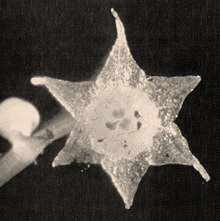Lacandonia
| Lacandonia | |
|---|---|
 |
|
| Flower of Lacandonia schismatica | |
| Scientific classification | |
| Kingdom: | Plantae |
| Clade: | Angiosperms |
| Clade: | Monocots |
| Order: | Pandanales |
| Family: | Triuridaceae |
| Genus: |
Lacandonia E.Martínez & Ramos |
Lacandonia is a mycoheterotrophic plant that contains no chlorophyll and has the unusual characteristic of inverted positions of the male (androecium) and female (gynoecium) floral parts, something that had not been seen in any other plants with the occasional exception of some individuals of the related Triuris brevistylis.
Lacandonia is a small parasitic plant that lacks chlorophyll and has a rhizomatous, mycotrophic habit. This genus exhibits racemous inflorescences and bract-like leaves. The flowers are actinomorphic and are considered "inverted" from the typical flower arrangement–usually 3 (but sometimes two to four) stamens are in the center of the flower surrounded by 60 to 80 pistils. This characteristic where the position of the androecium and the gynoecium are inverted is unique in the known and described taxa of flowering plants.
Flowers of Lacandonia are bisexual and self-pollinate and fertilize before the flower opens (preanthesis cleistogamy). They are true flowers as opposed to pseudanthia as had been suggested earlier in the literature. The three-celled pollen grains germinate within the anthers and the pollen tube grows through the receptacle to reach the ovaries. L. schismatica can be found flowering year-round when its environment is moist enough, with a particularly active flowering period in November and December. Owing to the prenathesis cleistogamy, a form of autogamy (self-pollination), the known population of L. schismatica lacks genetic variability and has a high instance of homozygosity. The haploid chromosome number of this species is n = 9.
...
Wikipedia
